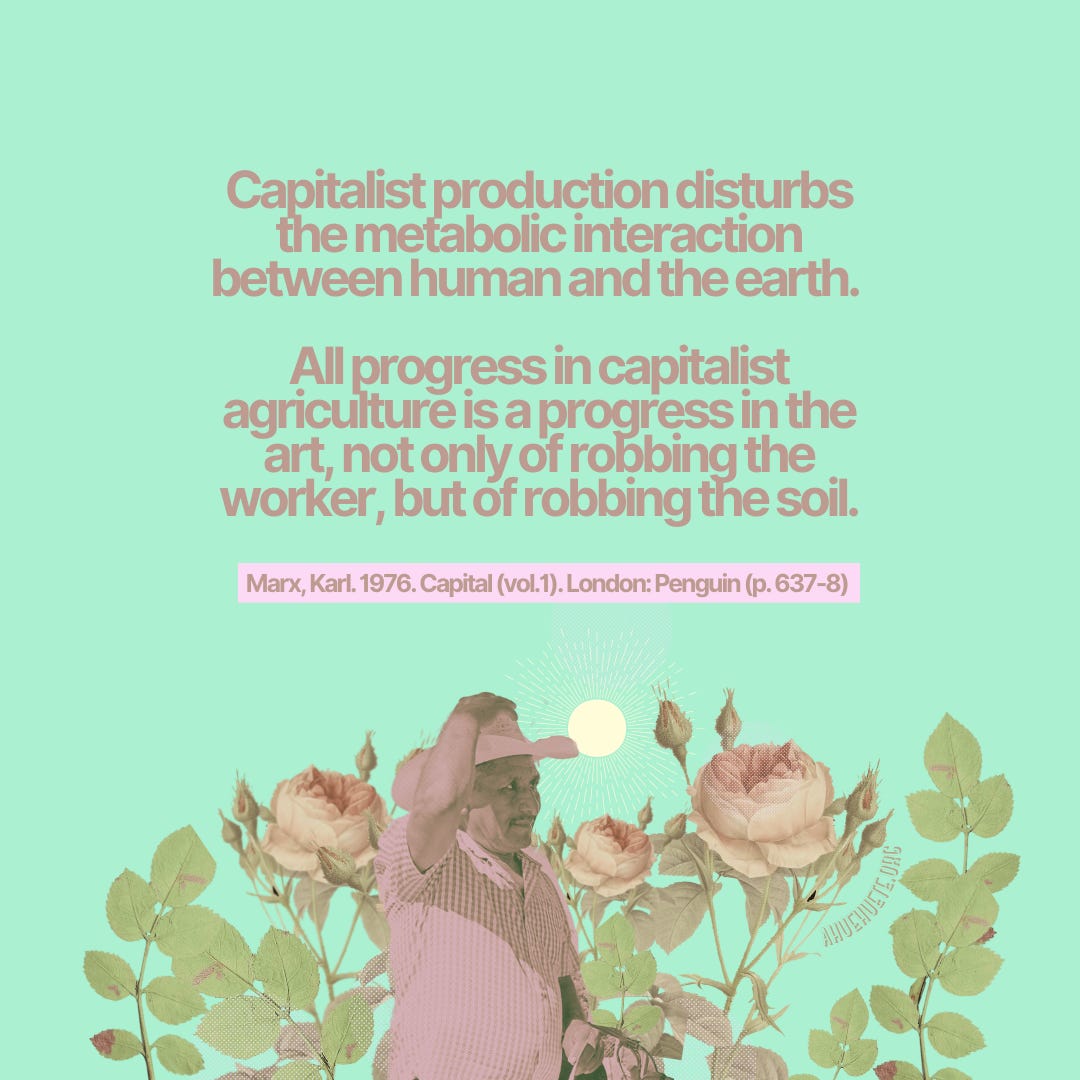Red Blood, Green Energy
Mexico was the country with the highest recorded number of killings of land defenders murdered every month», stated a new report titled Decade of Defiance.
Capitalist production…
disturbs the metabolic interaction
between [hu]man and the earth…
All progress in capitalism [...]
is a progress in the art,
not only of robbing the worker,
but of robbing the soil.
– Karl MarxRed Blood, Green Energy
The coast of Oaxaca is a territory abundant in natural resources: water, forest and mountains frame the landscape. And for more than five decades, peasant struggles against land privatization rise with the sun daily1.
Nearly 20% of Oaxaca is covered by the Verde (or Atoyac) River Basin. Only the Verde River is permanently present among the area's fluvial currents; the rest being seasonal. As EJAtlas reports, the livelihoods of the Mixtec, Chatino and Afro-Mexican peoples in the Sierra Sur of Oaxaca are centered on the resources from the Verde River. Before Hurricane Paulina (2007) most of the population was dedicated to the sale of lemons.
Cattle ranching, together with the selling of fresh cheeses to neighboring towns, became the primary economic activity in the aftermath of the natural disaster. Then, the hydroelectric entered their lives.
Restrictions protecting these streams were lifted in June 2018 by presidential decree — still operating under the rule of then-president Enrique Peña Nieto — in order to establish state water reserve zones. The communities filed an injunction, asserting their freedom to unrestricted natural resources, emphasizing as well that access to prior, meaningful consultations between the State and their communal assemblies had been violated by the former.
On May 3, 2022, Paso de la Reina celebrated the decree's dismissal. The people appeared victorious; they had been able to stop the water concessions through their committed struggle. Or so it seemed.
The Scrape of Water
On March 24, 2006 Mexico’s federal electricity commission (CFE) announced the official construction of the Paso de la Reina Multipurpose Hydroelectric Development in the state of Oaxaca. The dam would measure 195 meters and have a direct impact on 3,100 hectares in 6 municipalities and more than 40 localities2.
Residents of the river's banks had known since the 1960s that tests had been conducted in their localities to boost the construction of the dam, but it was not until 2006 that the Federal Electricity Commission (CFE) made the information public3.
Faced with the threat, on June 9, 2007, COPUDEVER arose. This collective, made up of women, men and others, committed themselves to unify for one purpose: to defend their lands from the State and capital’s looming, meandering pace.
But the vampiric thirst for profit does not relent, always ready for combat regardless of its seemingly infinite bodycount.
Paso de la Reina: Capital
In 2018, ex-president Peña Nieto (EPN), with no prior consultation as indicated in the International Labor Organization, issued a decree to lift the ban for various river basins in the country. This decree compromised 70% of the watersheds protected from exploitation, including from industrial and extractive industries.
In January 2021, the residents of the indigenous community of Paso de la Reina, in the southern highlands of Oaxaca, locked themselves in their homes. Fear led to the suspension of daily activities, such as soccer after work in the fields. For eleven months, basketballs and volleyballs stopped bouncing on the courts.
Terror further shook the community when in March, two months after Heras' murder, four other defenders of the territory were killed4. Educa Oaxaca documented how the Mixteco, Chatino and Afro-Mexican peoples have led a struggle against the Federal Electricity Commission (CFE) to build the Paso de la Reina Hydroelectric Dam, announced in 2006, directly affecting at least 17,000 people on the Río Verde.
Oaxaca ranked first among the states with the highest number of lethal attacks against environmental defenders last year. Many committed to the protection of the river and the articulation of the communities for the defense of life were murdered.
Couldn't care less for green, unless wallet-sized
Reuters5 reports that the Canadian company ACOx.TO won an international arbitration case against Mexican state power utility Comisión Federal de Electricidad (CFE) last year, and as a result, CFE was ordered to pay restitution of around $85 million. On November 30, the Mexican State gave a contract for 893 million dollars to the consortium led by the Austrian Andritz for the modernization of 9 of the 14 hydroelectric plants announced by the president.
However, the Paso de la Reina hydro-project, a US$600 million investment, was first proposed in 2006. Desinformémonos6 has documented the multiple forms of resistance from the communities along the years.
They have built a network along the region, shared experiences in several assemblies after resisting for more than ten years, when extractivism intensified in the country. Despite the threats and assassinations against defenders of the territories, they consider that organization and regional articulations of their struggle are essential.
It came as a surprise, after such contention, that due to the lack of popularity elicited by the extractivist project, the populist president López Obrador expressed on 2020:
«no new dams, the Paso de la Reina dam will not be built».
However, weeks later, the impact report of the hydroelectric for «renewable energy PH Río Verde», promoted by the company ENERSI was published by the Ministry of the Environment7. The project was boosted as a priority of the Lopez Obrador administration.
On May 3, 2022, the day of the beginning of the agricultural cycle in the farming villages, the Official Journal of the Federation published a decree of the Ministry of Environment and Natural Resources (SEMARNAT) in which the amendment made on June 6, 2018 by Peña Nieto is left without effect. In it, a removal of the protection of rivers and watersheds was put in place, offering the service to individuals or companies without the consent of the originary peoples and communities that inhabit those territories.
Filogonio
He was native of the indigenous Chatino people, active in the defense of the Verde River, when attempts to impose hydroelectric dams began and the extraction of stone materials intensified8. Filogonio was 60 years old, and a family man. He was dedicated to the production and sale of lemons. He also drove a pick-up truck used as transportation for the community within the municipality, in the absence of public transportation.
He was shot to death in it on October 26, 2022, in the community of Piedra Blanca. The attack took place as he stopped to help a female passenger get off the vehicle, and a motorcycle driver shot him at point-blank range, leaving him on the side of the road.
"Filogonio was the one who initiated the request for precautionary measures for the community, and also the most visible comrade in that case," explained Angélica Castro Rodríguez, a sociologist from Educa Oaxaca A.C., an organization that has accompanied the process of defending the Verde River against hydroelectric projects on the coast and southern highlands of the state of Oaxaca.
The expropriation […] from the soil is the basis of the whole process
The construction of hydroelectric dams on Mexican rivers has led to the displacement of thousands of families9.
According to the independent collective COPUDEVER, corporations operate by visiting each family individually to force them to hand over their land, with promises of relocation and compensation that are later not fulfilled. The consultations are not carried out through assemblies.
According to one of the testimonies collected by the Movement of People Affected by Dams and in Defense of Rivers (MAPDER), those in charge of “convincing” communities members to sell their lands even threaten to kill them.
“I told him that the land was not being sold. And do you know what he answered me? That, if the land was not sold, the owner of the land would disappear and then the widow would sell it”, said the resident threatened of eviction by the construction. [Report by Dam Watch International.]
Green Energy
In an insightful report by Avispa Media, Renata Bessi addressed a clear link between the strategies of the European Green Deal and what the EU is proposing to Mercosur10. In the plans issued by the Green Deal, emphasis on access to ‘green’ resources is key.
Except none of these raw materials are found in the European territory.
They are in Africa, and above all, in South America. Different studies have warned that the terms of the deal continue the colonial and unequal logic of the international division of labor. That is to say, they stimulate ‘industrial’ production in Europe while promoting the plunder of natural resources in the ‘Global South’. All of these products will have zero export tariffs. Minerals like iron will also have duty fees reduced to zero within a ten year pact.
A study indicates that, with the deal, there will be an increase of 540% in the exportation of ethanol, 55% for poultry, 60% in coffee, and 50% in beef. The agreement between the EU and Mercosur opens the doors of the South American countries to European extraction.
According to its documents, the Green Deal seeks the protection of European natural capital, which includes its biodiversity and water resources. Scientists stress the outdatedness of this vision from an environmental point of view.
“In the 21st century, we know that the planet operates as a large bloc with its complex but integrated biomes. There is no point in protecting European natural capital if the Amazon, biome with the greatest capacity to capture carbon on the planet isn’t protected.”
This emphasis isn’t exclusive of the ‘Global North11’, however. «The country must drastically enhance its green energy output», according to Marcelo Ebrard, Mexico's foreign minister and potential 2024 new State ruler12, to guarantee that commodity production adheres to global environmental norms13.
New Royals
In an 11-minute phone-call, right after his victory, Luiz Inácio Lula da Silva received a presidential invite to Mexico towards the end of November to join the Summit of the Pacific Alliance (GDP US$2.02 trillion). Lula praised his interlocutor, López Obrador, saying:
«your presidency is an extraordinary success for Mexico. Your experience can help us a lot...»
The Pacific Alliance is the sixth largest exporter, and 43% of the GDP in Latin America and the Caribbean. Its mission lists «an attempt to promote the trade with Asian economies». Nevertheless, China's growing presence in Latin America has sparked U.S. interest in reclaiming the region.
NAFTA 2.0
NAFTA terminated on July 1, 2020. The United States-Mexico-Canada Agreement (USMCA), or NAFTA 2.0, did, however, extend NAFTA Chapter 11 ISDS rights. That three-year window is closing, and investors are suggested to file a Request for Arbitration by July 1, 2023.
The USMCA removed ISDS protections for US investors in Canada and Canadian investors in the US. The investor-state dispute settlement (ISDS) allows countries to be sued by foreign investors for certain state choices «affecting direct investment».
The Mexican State implemented a number of policies that favor the state-owned electrical firm CFE and the state-owned oil and gas company PEMEX over foreign investors. After this, the US and Canada activated the State-to-State dispute resolution mechanism under Chapter 31 of the USMCA.
Mexico is a main corn client of the United States, importing annually 17M tons from its northern neighbor. However, a new GMO ban proposal posits transgenic seeds endanger corn varieties, and opposes glyphosate. As soon as these news spread, the US agricultural groups urged their government to challenge Mexico's decree under the USMCA deal.
Walmart
Simultaneously, López Obrador granted a tariff-free license to the American multinational corporation Walmart. Walmart de Mexico posted a net profit of 12 billion MXN. The State announced it would end bean and white corn exports, and ease sanitary measures on key foods (!) to ‘combat inflation’.
López Obrador pointed out that the chain, Walmart, alone distributes 25% of all the food in Mexico.
AMLO assured that the other two commodity retailers under the «Opening Deal Against Inflation and Famine», Soriana and Chedraui, are «complying with the price standard», although the quality of the edibles appears to rely on the honor code system of the corporations.
The deal supplies Walmart with a Single Universal License by the State, expediting all import and trade of food. Walmex became the main issuer in the Mexican Stock Exchange's Prices and Quotations Index, surpassing Slim’s América Móvil, which held the title until last month. The State announced it would end bean and white corn exports, and ease sanitary measures on key foods.
USCMA, and a broken heart
Mexican bureaucrat and economy minister Tatiana Clouthier resigned less than two years after taking on the job. She was replaced amid a USMCA (NAFTA 2.0) dispute that could reshape the nation-state’s dynamic with the US energy sector. The quarrel—led by the US with Canada joining soon after— contests legislative measures to bolster State firms CFE and Pemex.
Pemex Exploración y Producción (PEP) awarded, without any bidding process, a 1.477 billion dollar contract to Opex Perforadora, a company created three days before the present six-year term by the Bejos family, close to former president Peña Nieto.
The dispute centered on what the US and Canada see as Mexico’s attempts to «unfairly favor national energy companies—Pemex and Comisión Federal de Electricidad—in the power and oil field».
«The way we are going to generate electricity is the oldest way that exists in the world, generating energy through water, but it is efficient, economical and above all it is base energy for a national electric system», Espino Arenas assured, spokesperson for the company ENERSI.
The intention to generate renewable electricity through the hydrological component of the Armería River, allegedly14 "arises from the current energy trend, where the economic benefits of renewable energies have become increasingly relevant, as they contribute to reduce the risks associated with price volatility."
Twelve months ago, José Eduardo Espino Arenas, the developer ENERSI's primary chief operating officer, agreed with the state governor that the signing of this deal was «historic», as it was the first time in Mexico that the state government, the Ministry of Rural Development, the water consumers, and the entrepreneurial spirits turned developers are «coming together» to be able to generate electricity.
Coming together, like the hue of green from the producers of renewable energy, and the scarlet blood flowing from the corpses of the land defenders that surround the Verde River Basin.






No comments:
Post a Comment